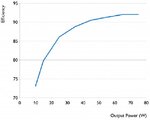T
treez
Guest
Hello,
We dispute Efficiency claims of 89% in the datasheet of this 40W Phillips Xitanium outdoor offline LED driver…..
Xi LP 75W 0.2-0.7A SN 230V S240 sXt
Topology:
However, when we opened it up, we found it was a L6562 controlled Boost PFC stage, followed by an L6562 controlled isolated Flyback stage. There is also a Viper controlled little Buck converter to provide bias power. The Boost PFC output capacitor is a 22uF , 450V electrolytic.
This surely could not be 89% efficient?
If it was that efficient, then that would mean the Boost PFC would be about 96% efficient, and the Flyback would be about 93% efficient. That surely could not be possible? In my experience, I find 90% tops is about the efficiency of low power offline flybacks, even with BCM operation
The L6562 controller operates in Boundary Conduction Mode, so turn on switching losses are about zero, but turn-off switching losses are high.
We won’t yet have time to test it for ourselves as we are way too busy at present.
Electrolytic capacitor
Also, why does the datasheet claim that its has “ultimate robustness” and ” long lifetime” when it has a big internal electrolytic capacitor.?
High switching frequency at lighter loading
Also, its necessary for offline LED drivers to maintain high power factor right down to 25W. Now, if operating in BCM, then that means that as the load gets lighter, the switching frequency of a BCM controller will increase…..As such, switching losses will increase. If the switching frequency needs to go above 150kHz to maintain BCM operation, then that has severe repurcussions in terms of conducted EMC.
The L6562 datasheet makes no mention of a maximum frequency limitation, or a minimum off time.
Maybe they are operating the L6562 as a constant off time controller? ..which is possible with addition of a few extra components….however, the L6562 doesn’t possess the necessary internal circuits to allow it to maintain high enough power factor when operated in constant off time.
Datasheet:
Xi LP 75W 0.2-0.7A SN 230V S240 sXt
Datasheet available here…..
https://www.lighting.philips.co.uk/oem-emea/support/technical-downloads
L6562 Datasheet:
https://www.st.com/en/power-management/l6562.html
Do you agree this LED driver couldn’t be that efficient?
We dispute Efficiency claims of 89% in the datasheet of this 40W Phillips Xitanium outdoor offline LED driver…..
Xi LP 75W 0.2-0.7A SN 230V S240 sXt
Topology:
However, when we opened it up, we found it was a L6562 controlled Boost PFC stage, followed by an L6562 controlled isolated Flyback stage. There is also a Viper controlled little Buck converter to provide bias power. The Boost PFC output capacitor is a 22uF , 450V electrolytic.
This surely could not be 89% efficient?
If it was that efficient, then that would mean the Boost PFC would be about 96% efficient, and the Flyback would be about 93% efficient. That surely could not be possible? In my experience, I find 90% tops is about the efficiency of low power offline flybacks, even with BCM operation
The L6562 controller operates in Boundary Conduction Mode, so turn on switching losses are about zero, but turn-off switching losses are high.
We won’t yet have time to test it for ourselves as we are way too busy at present.
Electrolytic capacitor
Also, why does the datasheet claim that its has “ultimate robustness” and ” long lifetime” when it has a big internal electrolytic capacitor.?
High switching frequency at lighter loading
Also, its necessary for offline LED drivers to maintain high power factor right down to 25W. Now, if operating in BCM, then that means that as the load gets lighter, the switching frequency of a BCM controller will increase…..As such, switching losses will increase. If the switching frequency needs to go above 150kHz to maintain BCM operation, then that has severe repurcussions in terms of conducted EMC.
The L6562 datasheet makes no mention of a maximum frequency limitation, or a minimum off time.
Maybe they are operating the L6562 as a constant off time controller? ..which is possible with addition of a few extra components….however, the L6562 doesn’t possess the necessary internal circuits to allow it to maintain high enough power factor when operated in constant off time.
Datasheet:
Xi LP 75W 0.2-0.7A SN 230V S240 sXt
Datasheet available here…..
https://www.lighting.philips.co.uk/oem-emea/support/technical-downloads
L6562 Datasheet:
https://www.st.com/en/power-management/l6562.html
Do you agree this LED driver couldn’t be that efficient?
